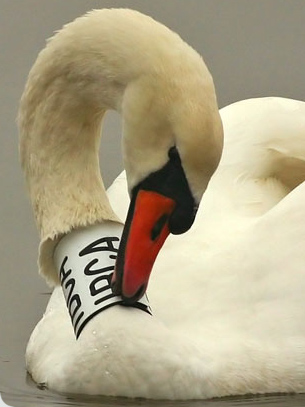Colour Mark Coding Summary
PRIVACY
The in this application stored information about names, addresses etc will not be shared with third parties.
--- --- ---
Colour Mark Coding Summary and
Comprehensive guide to colour mark recording in DemOn: https://app.bto.org/static/files/demon/demon_colour_mark_recording.pdf
(c) Mark Cubitt 2025.
This document describes the standard coding specification adopted by the British Trust for Ornithology for recording colour marks.
Each leg bone can have up to four colour marks attached. Wing and neck up to two. Each of these body parts are known as positions. Marks are always recorded from the top down. The reading of any digits e.g. BIN should be from left to right as if you were reading out the letters from a word. The orientation of the writing on the ring whether it goes round or up or down should not affect the code.
The first two characters denote the position LB: left below the inter-tarsal joint ("knee"), LA: left above, RB: right below, RA: right above, NC: Neck collar, RW: right wing tag, LW: left wing tag. NS: Nasal tags and saddles
The colour marks at each position are listed from top down separated by commas (,). So for red over BTO ring on the right leg on the tarsus (below the tarsal joint) we have RBR,M.
If colour marks are on multiple positions each position code is separated by a semicolon e.g. LAG,Y;RAP,M .
If the colour mark has digits enscribed these are recorded after the mark's colour code in parentheses. The colour of the digits is required this is recorded as the second colour of a two colour code e.g. a Green darvic with Black digits on a Gull's left tarsus with code XSL would be LBGN(XSL);RBR,M when the red over BTO position is added. If there are bars around the ring then these are recorded using the forward slash (/) symbol.
Example 1: letter R separated from letter B by a bar (all black) round a white ring (on the left tarsus) would be LBWN(R/B);
Example 2: as example 1 except that the bar is replaced by a bar at each end of the ring would be LBWN(/RB/).
If a two-colour mark is used with different colour digits on each it should be recorded as two marks; if they are the same colour then see below under two colour marks.
To record leg flags a suffix to the colour of the letter F. e.g. LBRF is a red flag on the left tarsus. To record a tall ring a suffix code of T is used. For ‘Wasp’ rings with positional bands on a (tall) ring a suffix of a hash (#) is used; the wasp bands are recorded as for enscriptions except that the only characters allowed are 0 for ‘no band’, 1 for thin band and 2 for ‘thick band’. For a yellow wasp ring with black bands on the left tarsus with a thin band over a thick band over ‘no band’ is coded LBY#N(120).
Nasal tags and saddles are both recorded using the NS position code. Nasal saddles follow the standard convention e.g NSRB(QQ) for a Red Nasal Saddle with a Blue "QQ" enscription. Nasal tags always come in pairs and are treated as two marks on the same position with the tag on the bird’s right side being recorded first. Tags also have a shape which is recorded after the colour code within square parentheses. Tag shape codes are: square [Q], rectangle [R], triangle [T], circle [C], hexagon [H], octagon [O], star [S]. For a bird with a red, square tag on the right and green circular tag on the left the coding is NSR[Q],G[C].
For two-colour marks a number after the colour indicates the type. Blank is the default for a single colour, 2 for narrow (multiple stripes of each colour) stripes and 3 for thick (one stripe of each colour) stripes. e.g. RAPC2,M for a Pale Blue/Dark Pink narrow striped ring over BTO metal. The top colour, if applicable, should be the first letter of the code. If a striped colour mark has digits enscribed that are all the same colour then the colour code of the digits follows the colour codes for the ring. e.g. a white and green thick striped neck collar with dark blue digits XYZ would be recorded as NCWG3B(XYZ).
Observations of Colour Marks can sometimes lead to partial or incomplete records.
In these cases a “?” character can be used in place of a single colour code or enscription colour character or in place of the Left or Right indicator for the mark position i.e. ?B, ?A or ?W. For example if the enscription colour is not visible then a code such as LBO?(AHT) could be used.
Colour codes for colour marks :
R = Red
P = Pale Blue
W = White
O = Orange
G = Dark Green
C = Dark Pink (Carmine)
L = Light Green (Lime)
K = Light Pink
N = Black (Niger)
B = Blue (Dark)
M = Scheme Metal Ring
V = Violet/Mauve/Purple
Y = Yellow
S = Silver/Grey
A = Other metal ring
U = Brown (Umber)


